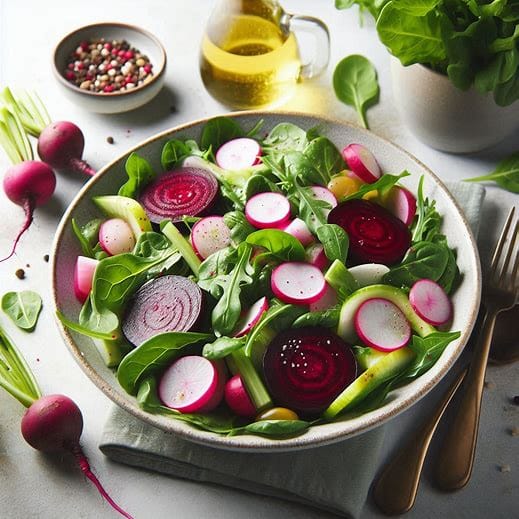Nitric oxide (NO) is a powerful molecule in your body that helps your blood vessels relax, improving blood flow and heart health. The best part? You can boost your nitric oxide levels just by eating the right veggies! Some vegetables are packed with nitrates, which your body turns into nitric oxide, giving you benefits like lower blood pressure and even better exercise performance. You need about 300 mg of nitrates a day to get the full benefits seen in research studies. In this article, we’ll look at the top 10 best vegetables that naturally increase nitric oxide, and show you how to add them to your diet for the best results!
Arugula (Rocket Lettuce)

Why It’s Great: Arugula is the highest known nitrate-containing vegetable, with concentrations reaching up to 7,000 mg/kg. Typical levels are about 450 mg/100g. Just a small handful can significantly boost nitric oxide production.
How to Use: Add it to salads, sandwiches, or blend it into green smoothies.
Spinach

Why It’s Great: Spinach is packed with nitrates and provides a substantial boost to NO levels. 100g (3.5 ounces) of raw spinach has around 70-200 mg of nitrates. Exact amounts depend on growing conditions and seasonal variations.
How to Use: Eat it raw in salads, blend into smoothies, add it to your fresh vegetable juice or lightly steam it.
Beets (Beetroot)

Why It’s Great: Beets are famous for their high nitrate levels and are often used to boost exercise performance and lower blood pressure. One cup of raw beets contains as much as 400-500 mg of nitrates. A cup of beet root juice has about 200 mg of nitrates.
How to Use: Enjoy raw, roasted, juiced, or blended into smoothies.
Swiss Chard

Why It’s Great: Swiss chard is closely related to beets and is similarly high in nitrates, making it an excellent choice for supporting NO production.
How to Use: Use in salads, sautéed dishes, or green juices.
Celery

Why It’s Great: Celery, especially the stalks and leaves, is a rich source of dietary nitrates. It’s also hydrating and low in calories, making it a great addition to juices and smoothies.
How to Use: Add to salads, soups, or fresh-pressed juices.
Lettuce (Romaine, Butterhead)

Why It’s Great: All of the lettuce species are high in nitrates. Even iceberg lettuce has a decent level of nitrates. A spring mix is a great option for salads. Typical nitrate levels for lettuce are around 150-200 mg for 3.5 oz (100 g) serving.
How to Use: Use as a salad base or in wraps and sandwiches.
Bok Choy (Chinese Cabbage)
Why It’s Great: While not as nitrate-rich as spinach or arugula, kale still contains good amounts of nitrates and is packed with other health benefits like antioxidants.
How to Use: Use raw in salads, steamed, or blended into smoothies.
Cilantro

Why It’s Great: Cilantro (or coriander leaves) is another very high-nitrate leafy green that can enhance NO levels and add flavor to dishes. Cilantro is also great for detoxifying heavy metals, so it is a win-win for you.
How to Use: Sprinkle fresh cilantro on salads, salsas, or add to juices.
Bonus Tip:
To maximize nitric oxide production, try combining several of these vegetables in one meal, such as a salad or a green juice, to create a synergistic effect. Consuming them raw or minimally cooked is ideal, as high heat can reduce nitrate levels.
If you’re aiming for the highest NO boost, a salad with arugula, spinach, and beets, topped with some radish and celery, will deliver a potent dose of dietary nitrates!


Why It’s Great: Bok choy contains moderate levels of nitrates and is also rich in vitamin C, which can help stabilize and preserve nitric oxide.
How to Use: Use in stir-fries, soups, or raw in salads.
Radishes

Why It’s Great: Radishes are a great source of nitrates and also provide a peppery flavor to dishes, making them ideal in salads or as a garnish.
How to Use: Slice raw into salads or add to sandwiches.
Kale

Why It’s Great: While not as nitrate-rich as spinach or arugula, kale still contains good amounts of nitrates and is packed with other health benefits like antioxidants.
How to Use: Use raw in salads, steamed, or blended into smoothies.
Cilantro

Why It’s Great: Cilantro (or coriander leaves) is another very high-nitrate leafy green that can enhance NO levels and add flavor to dishes. Cilantro is also great for detoxifying heavy metals, so it is a win-win for you.
How to Use: Sprinkle fresh cilantro on salads, salsas, or add to juices.
Bonus Tip:
To maximize nitric oxide production, try combining several of these vegetables in one meal, such as a salad or a green juice, to create a synergistic effect. Consuming them raw or minimally cooked is ideal, as high heat can reduce nitrate levels.
If you’re aiming for the highest NO boost, a salad with arugula, spinach, and beets, topped with some radish and celery, will deliver a potent dose of dietary nitrates!


